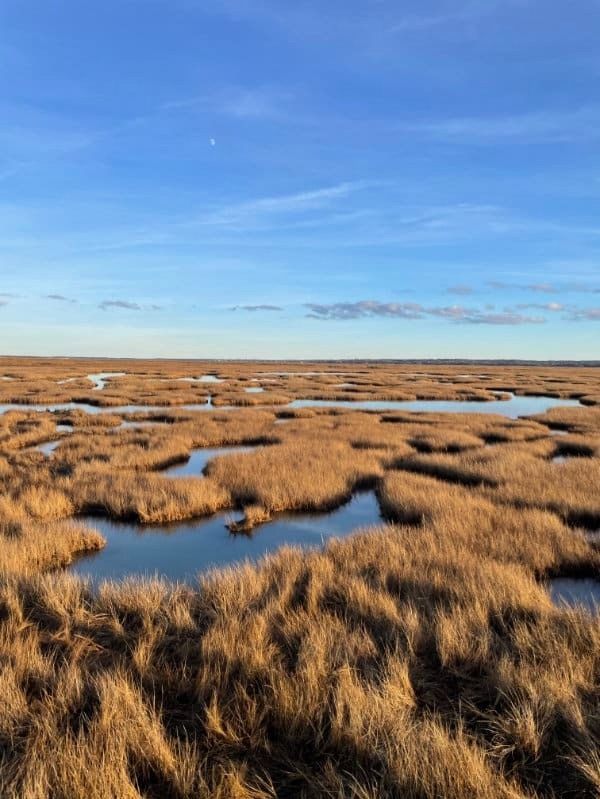Reviving wetlands threatened by rising sea levels poses a formidable challenge, yet scientists have made significant strides toward pinpointing potential solutions.
 A salt marsh in Barnstable, Massachusetts, shows signs of erosion and drowning as the sea level rises (December 02, 2022). Image Credit: Erin Peck
A salt marsh in Barnstable, Massachusetts, shows signs of erosion and drowning as the sea level rises (December 02, 2022). Image Credit: Erin Peck
Large-scale dam removal initiatives have drawn attention in response to climate change to replace the coastal wetlands that decrease flooding, filter water, and provide homes for species.
However, in a recent Science publication, scientists concluded that most American rivers would not respond well to this tactic.
They claimed that insufficient sediment was the cause. Almost three out of every four of the approximately 5,000 rivers examined could not supply enough sediment to keep up with the rise in sea level in the coastal areas they were connected to. Almost half lacked the required sediment quantity by a factor of at least ten.
This is the first national research to inspect the quantity of watershed sediment rivers deposit into coastal areas. Until now, studies have concentrated on a small number of significant rivers, such as the Mississippi, and steep rivers, such as the Elwha in Washington, that are not typical of most rivers in the contiguous United States.
The majority of US watersheds are small and, therefore, not the main cause of sediment accumulation in wetlands, the researchers claim. Most of the dams are located on these small rivers.
The Elwha is the poster child for a dam removal project restoring coastal sediment, and for good reason: it liberated an enormous amount of sediment and sand. However, rivers along the East and Gulf coasts are less steep than on the West Coast, and they have less sediment that could potentially reach wetlands - wetlands that are larger, requiring more sediment to keep them above rising seas. Basically, the numbers don’t add up.
Scott Ensign PhD, Research Scientist, Stroud Water Research Center
Scott Ensign PhD studies freshwater streams and rivers non-profitably around the world.
The expansive and comprehensive spatial analysis conducted by the authors strongly suggests that sediment supply of most coastal watersheds is inadequate to sustain tidal wetlands as sea level rises. In other words, sediment will not save them.
Christopher Craft PhD, Professor, University of Indiana
Christopher Craft focuses on wetland restoration and climate change.
Ensign and his co-authors, Joanne Halls from the University of North Carolina and Erin Peck from the University of Massachusetts, used publicly available data from the US Geological Survey and National Oceanic and Atmospheric Administration to model the supply of watershed sediment to coastal wetlands using ArcGIS Pro technology from Esri. They then associated their predictions to tidal wetlands around the US with previously reported rates of change.
Ensign explains, “By and large, the sediment that saves most wetlands from drowning doesn’t come from the river upstream. In many places on the East Coast, removing dams won’t help. We have to look elsewhere. These results, and the local variations documented by mapping the entire coastal U.S., provide essential guidance to managers and scientists, documenting where future efforts should focus on other processes beyond watershed sediment.”
James Pizzuto, PhD, a Professor of geological sciences specializing in river science at the University of Delaware, said that the researchers skillfully addressed a difficult problem.
Increasing the amount of plant matter, organic carbon, and mineral sediments in wetland soils is one goal of these initiatives, explained Donald F. Boesch, Professor Emeritus of the University of Maryland Center for Environmental Science.
Boesch adds, “This is true both where they are sediment-starved and where sediments are being diverted to build and maintain wetlands experiencing high rates of relative sea-level rise, such as in the Mississippi Delta.”
Future research is required to precisely estimate the amount of sediment trapped behind a given dam and to forecast how it will affect tidal wetlands downstream.
Ensign says, “Across the board, the most important action for saving tidal wetlands is to allow them to migrate upslope. In some areas, this will require restoring natural hydrology and preserving low-lying land. Direct application of sediment and other engineering approaches can also be useful at very local scales.”
The National Science Foundation funded the research.
Journal Reference:
Ensign, H, S., et al. (2023). Watershed sediment cannot offset sea level rise in most US tidal wetlands. Science. /doi/10.1126/science.adj0513